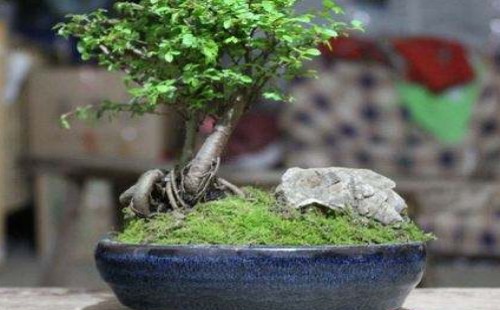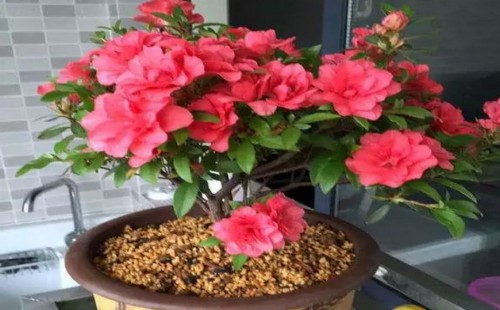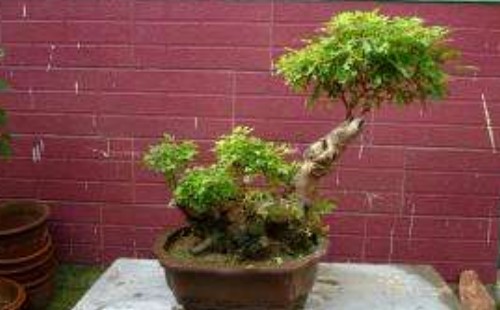Maintenance and management of balcony bonsai in summer
Many potted friends like to grow some bonsai green plants on their own balcony, on the one hand, they can decorate the space, on the other hand, they can also appreciate them, and at the same time, they can bring us a touch of green and cool feeling in summer. However, precisely because the summer weather is hot and the temperature is high, bonsai plants will become unbearable, so the maintenance and management work becomes very critical. So, how to maintain and manage the balcony bonsai in summer?

The sun is often scorching in summer, the heat is unbearable, especially in the middle of summer, so the maintenance and management of bonsai often brings a lot of difficulties. A little carelessness may lead to poor growth of bonsai plants, while heavy plants may cause death. However, no matter whether the balcony bonsai plant is poor growth or lethal phenomenon, it will often bring us some losses, loss will affect the viewing. Today, the editor will share with you the maintenance and management methods and skills of balcony bonsai in summer.
First, balcony bonsai summer cutting management
As the high temperature and hot weather environment in summer will have a certain impact on the growth of balcony bonsai plants, especially water evaporation too fast, in order to reduce water evaporation, in addition to timely replenishment of water, but also need to do a good job of summer pruning, cut off the excess branches and leaves to reduce water evaporation, because bonsai plants often rely on leaves to evaporate a lot of water. In order to do a good job of pruning, we need to master the basic principles of summer shearing.
1. In summer, the canopy of bonsai plants should be well ventilated and transparent, which is more conducive to plant growth and reduce the chance of being infected with diseases and insect pests. In this case, it is mainly to take the way of thinning to cut off the branches that are too dense to improve the ventilation and light transmission effect of the tree, and if necessary, it is necessary to combine with picking leaves.
2. In the process of summer pruning, it is necessary to top the twigs in time, mainly in order to avoid the phenomenon of excessive growth of branches and leaves and destroy the original beautiful plant type of bonsai plants. At the same time, it can also accelerate the Lignification of new branches. For flowers and plants that bloom in summer, it can also promote the differentiation and formation of flower buds and improve the quantity and quality of flowering.
3. Cut off all the old, weak, sick and residual branches to avoid wasting nutrients and water, and original creation can also avoid the spread of diseases and insect pests. As for the weak branches that may change their appearance after partial cutting, they can be cut short appropriately and do not need to be cut off completely. If it is accidentally cut, it is necessary to continue to cultivate new branches in the position to be cut in the later stage, so as not to damage the appearance of the branches.
4. For tree species such as Fatong and Bauhinia, it is easy to produce a large number of sprouting tillers in summer. If allowed to grow, it will not only disturb the tree shape, thus destroy the beauty of the plant, affect the ornamental, but also consume a lot of nutrients, so it needs to be erased in time.
In addition, in the process of summer pruning, we also need to master the basic requirements of pruning:
1. Whether it is cutting off the branches or truncating the branches, we are often required to put the knife in place as far as possible to keep the cut smooth. Must not directly break the branches, tear off, otherwise not only easy to hurt fingers, but also may cause tears to the branches of bonsai trees, not only affect the beauty of bonsai, but also affect its normal growth.
2. When truncating branches, it is generally necessary to reserve lateral buds as a spare, and the cutting incision should be kept at a distance of more than 1 cm from the remaining buds. If the distance is too close, the buds left behind are easy to die, and even if they stay, they will not have any effect.
3. When pruning or truncating large branches or sturdy roots with a diameter of more than 2 cm, we must maintain the smoothness of the incision to avoid frequent tear marks, and at the same time, we also need to apply preservatives to the cutting mouth in time to avoid the phenomenon of excessive water loss caused by sap extravasation, thus weakening the tree potential and increasing the risk of infection of diseases and insect pests.
II. Maintenance and management of balcony bonsai
Summer in addition to the balcony bonsai for scientific pruning, but also need to do a good job during the maintenance and management work, there are usually five taboos insurmountable.
1. Avoid sudden shade
When the summer temperature is as high as 28 °C, shading measures should be taken for the balcony bonsai in time, because many bonsai plants tend to go dormant after the temperature reaches 30 °C, thus stagnating their growth. However, if you move it to a cool place, you must not suddenly put it in the shade where the temperature is too low. It is generally appropriate to maintain a temperature difference of about 2-3 °C. Because if it is suddenly placed in the shade where the temperature is too low, it will be difficult for the plant to adapt to the new environment, and within a few days the leaves will wilt, the leaves will fall, and even the branches will wither to death.
2. avoid taking a bath in the afternoon
In normal times, bonsai plants can generally have full-day light bathing, especially positive bonsai plants, which should be provided with sufficient light. But in summer, because the temperature is high and the light is too strong, most plants should not be exposed to the sun for a long time. Especially around noon, it is often the time of day with the highest temperature. But during the period, bonsai can not be watered or sprayed, otherwise there will be a huge temperature difference in an instant, prone to the "steamed stuffed bun effect", which is often more fatal for bonsai plants. And watering and spraying should also avoid this period of high temperature, which is suitable for carrying out in the morning and evening.
3. Avoid drought
Due to the harsh high temperature environment in summer, the consumption of water is very large, so the basin soil is also very easy to dry quickly, so watering must be timely. Do not neglect to replenish water to bonsai because of being too busy or for other reasons, it is likely to make bonsai lack of water, withered and yellow, or even die. Under normal circumstances, it is necessary to supply water in time when the leaves wilt slightly after seeing the basin soil dry, and the leaves will quickly return to normal. Therefore, the summer watering must be timely, do not think of watering, do not think of watering, otherwise the bonsai plants will have problems sooner or later.
4. Avoid replenishing water
When the outside temperature in summer exceeds 28 °C, we should take shading and cooling measures in time. But in real life, many people spray water to cool down, thinking that doing so can not only play a cooling role, but also play the purpose of moisturizing. In fact, this is a misunderstanding, or even a wrong approach. Because when the outside temperature is too high, even if the water is sprayed and watered, the moisture will soon be evaporated, thus unable to achieve the purpose of replenishing water, and what is more serious is that it will form a large temperature difference in the local area after spraying and watering, thus causing some damage to the bonsai. After all, water needs a lot of heat to absorb in the process of evaporation.
5. Avoid fertilizing
For most bonsai plants, it is generally not suitable to fertilize in summer, even those flowers and plants that bloom in summer are not suitable for topdressing at flowering stage, especially in the middle of summer. In order to promote the flowering of plants in summer, many potted friends blindly fertilized them, which eventually caused fertilizer damage and sunburned the roots of the plants. It is mainly due to the rapid evaporation of water under high temperature in summer and the sudden increase of the relative concentration of fertilizer solution, which burns the roots of the plant. And in this case, the concentration of cells in the plant will be lower than that in the external environment, which will often lead to the flow of water from the cells in the plant to the soil, resulting in the death of the tree due to dehydration. Therefore, it is not suitable to fertilize the balcony bonsai in summer.
Time: 2019-05-29 Click:
- Prev

How do summer cuckoo bonsai survive the winter
The ornamental effect of summer cuckoo bonsai is often directly related to whether the growth environment is suitable and whether the means of conservation and management are scientific and reasonable. Because summer cuckoo is a variety of rhododendron, it retains or inherits many habits and characteristics of rhododendron, so there are only slight differences in conservation and management.
- Next

Maintenance of bonsai with bumps in bauhinia trees
Bauhinia knot bonsai shape is changeable, branches and leaves evergreen, blooming purple flowers accompanied by a touch of fragrance, high ornamental value. At the same time, the bauhinia also has indomitable vitality and can well adapt to the harsh growth environment. Bauhinia trees not only like light and warmth, but also endure shade and cold, and do not have high requirements for soil.
Related
- Fuxing push coffee new agricultural production and marketing class: lack of small-scale processing plants
- Jujube rice field leisure farm deep ploughing Yilan for five years to create a space for organic food and play
- Nongyu Farm-A trial of organic papaya for brave women with advanced technology
- Four points for attention in the prevention and control of diseases and insect pests of edible fungi
- How to add nutrient solution to Edible Fungi
- Is there any good way to control edible fungus mites?
- Open Inoculation Technology of Edible Fungi
- Is there any clever way to use fertilizer for edible fungus in winter?
- What agents are used to kill the pathogens of edible fungi in the mushroom shed?
- Rapid drying of Edible Fungi

